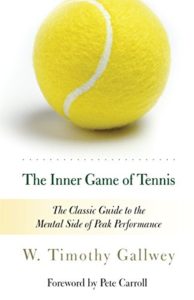
The Inner Game of Tennis is a book about the mental side of peak performance. It was written in the 70s by a tennis coach. The ideas in the book have larger appeal than just tennis players. It’s fascinating how much thought a tennis coach put into how people learn, and was able to distill methods that can be applied to other fields. There are familiar concepts from meditation like quieting the chatter of your mind by focusing it on your breath or the ball. He says: “What I really wanted, I realized, was to overcome the nervousness that was preventing me from playing my best and enjoying myself. I wanted to overcome the inner obstacle that plagued me for so much of my life.” This resonates with me, there are many situations where after enough practice, the bottleneck for your best performance becomes controlling your emotional state and calming your nervousness: job interviews, public speaking, playing chess etc.
Here are some concepts from the book:
The Two Selves: The book separates the mind into “Self 1” and “Self 2”, the “teller”, “internal critic” is Self 1 and “doer” is Self 2.
Non-Judgemental Awareness: It talks about non-judgemental awareness, to see what is happening rather than merely noticing how well or how badly it is happening. Neither the goodness nor the badness ascribed to the event by the player is an attribute of the shot itself. Rather, they are evaluations added to the event in the minds of the player. Nonjudgemental awareness might observe that during a certain match you hit 50 percent of your first serves into the net. Judgement results in tightness, and tightness interferes with the fluidity required for accurate and quick movement. You should free yourself from any emotional reaction to success or failure, simply know your goal and take objective interest in the results.
Trusting Self 2: Trusting and loving parent lets the child perform his own actions, even to the extent of making mistakes, because he trusts the child to learn from them. If a mother identifies with every fall of her child and takes personal pride in its every success, her self-image will be as unstable as her child’s balance. The same kind of detached interest is what is necessary to let your tennis game develop naturally. Remember that you are not your tennis game.
Picture Desired Outcome: Give Self 2 a clear visual image of the results you desire. Getting clearest possible image of your desired outcome is the most useful method for communication with Self 2.
Natural Learning: Too many verbal instructions interfere with one’s shotmaking ability. The more awareness one can bring to any action, the more feedback one gets from experience, and the more naturally one learns the technique that works best. No teacher is greater than one’s own experience. During play, observe different parameters like weight on your shoulder muscle, whether your racket moves from high to low or low to high, the weight shift in your feet etc. Simply observe without interfering.
Learning to Focus: To still the mind, one must learn to put it somewhere. It cannot just be let go; it must be focused. As one achieves focus, the mind quiets. As the mind is kept in the present, it becomes calm. Focus means keeping the mind now and here. In tennis, the most convenient object of focus is the ball itself. Focus is not achieved by staring hard at something. Natural focus occurs when the mind is interested. Every time your mind starts to leak away, simply bring it gently back.
